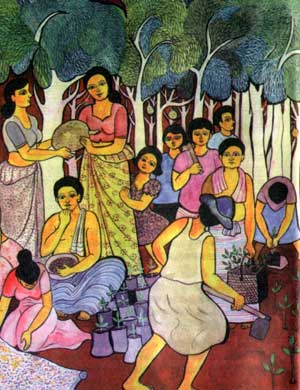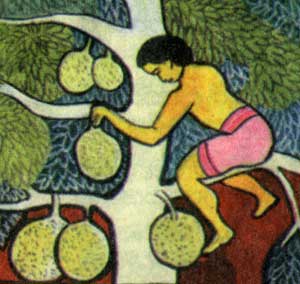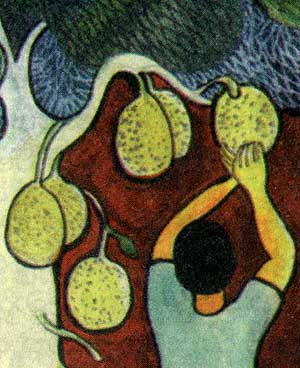
|

|

|

|
The Jackfruit
The jackfruit (Artocarpus integrifolia or Artocárpus heterophyllus) is a fast growing evergreen reaching a height of 8 to 20 metres and bearing the world’s largest fruit which grows from the trunk and main branches. The jackfruit is considered native to the rainforests of the Western Ghats (mountains) in India but is now common to most tropical lowland regions of South East Asia. Jackfruit and other starch plants (sweet potato, cassava, and breadfruit) are important food sources for local inhabitants and on many occasions serve to prevent starvation in tropical regions.
The jackfruit is a multipurpose tree. Its fruit is eaten green (peeled under running water to prevent it turning black) as a vegetable or ripe in desserts and main meals.
The jackfruit is a fine looking specimen with lush, glossy, dark green leaves and is extremely decorative in the home garden. Grafted trees bear fruit in about two to four years from planting. Trees grown from seed may take between three to eight years. Jackfruit is a tropical forest tree and while it will grow in poor stony soils it thrives in humid conditions with plenty of rainfall.
The jackfruit is well remembered and often avoided for its pungent aroma. Likened to the smell of rotting onions when ripe, the aroma exudes a banana pineapple smell when open. The ripe flesh tastes similar to banana and makes delicious ice cream. The bulbs can be cooked in milk and then drained. The milk will form an orange custard which can be eaten chilled, while the seeds are best boiled and when combined with a tomato sauce are not unlike baked beans. The seeds can also be wasted and ground into flour.
Handling the Sticky Jackfruit
Once the bulbs and seeds are extracted from the fruit, banish the remains to the compost.
Oil hands and knife before cutting the fruit because the jackfruit exudes a sticky white latex. It does this to attract bird life. The oil will prevent the latex from sticking to your hands and utensils. If you do encounter the ‘latex experience’, gentle scrubbing with tea-tree oil will remove it.
The Chinese consider the jackfruit pulp and seeds useful in overcoming the effects of alcohol. Latex from the stalk combined with vinegar is thought to heal the effects of snakebite.
Jackfruit Recipes
Jackfruit in Nasi Campur
Nasi Canipur is an Indonesian dish (campur meaning mixture). This dish is generally served on individual plates with a mound of steaming red rice surrounded by slices of fried tempeh, steamed vegetables, prawn crackers, hard boiled eggs, fresh bean shoots, cucumber and a pickle. The result is not unlike an Indian thali.
Use a full-grown unripe jackfruit (either the soft fruited Khuja or the firm fruited Ghila)
Cut the fruit into large chunks and place in a saucepan of lightly salted water and boil until tender. Separate the flesh from the rind and set aside the seeds for later use.
Fry some finely chopped onion with a clove of crushed garlic. When the onion is soft and transparent add a garam masala mix of chopped fresh chillies and coriander. Stir well and fry for one minute before adding the tender boiled jackfruit. Add enough coconut milk to make a sauce that will gradually thicken as it cooks. Take care not to let the curry become too dry.
Add more coconut milk or vegetable stock according to taste. Add also, a dash of soy sauce, fish sauce and lime juice.
Allow the curry to simmer for five minutes then remove from heat. The jackfruit will soak up the flavour of the curry while you prepare the other ingredients. Make sure to return the curry to the heat briefly before serving.
Jackfruit curry can be made by adding a variety of vegetables and served on a bed of rice and noodles.
The Ultimate Vegan Custard
Use the ripe flesh from the soft fruited jackfruit and press it through a wire sieve. This removes the hairs from the fruit. Add to the pulp an equivalent quantity of soy milk, a dash of nutmeg and raw sugar or honey to taste. Blend well with a hand beater or whisk. The custard can be served immediately or left to chill in the fridge.
Source: Perma Culture magazine, issue no. 57
| Living Heritage Trust ©2020 All Rights Reserved |